(This Retrospective article was published in the December 2007 issue of Rider.)
STORY and photography BY CLEMENT SALVADORI
Get on this little Adventurer, turn on the gas, flip the choke, push the button, and that cheerful two-stroke burble comes out the well-muffled exhaust.
Cruise down the suburban street, out into the country, engine warmed, drop the five-speed tranny down two gears, wind it out to the 8,500-rpm redline, shift, shift again, and a lightweight solo rider on a slight downhill gradient might be seeing 80 mph on the speedometer. Not bad for a little 185 back in those days, not bad at all. Although a couple of imperfections might be evident, especially if the rider pitched it into a decreasing- radius curve.
In the early 1970s there must have been somebody at Suzuki headquarters who was a numerologist, and felt that 185 had to be a lucky number. In 1971 there appeared the TS185 Sierra, a 183cc two-stroke single set up as a woods bike; followed by the GT185 Adventurer in 1973, this 184.8cc two-stroke twin street bike; and then the 1974 TC185 Ranger, a woods bike that was quite similar to the TS185, differing mostly with its dual-range transmission. Now that we have brought up the TS and TC, we’ll ignore them and focus on the GT.
In 1972 Suzuki began putting the GT (Grand Touring) prefix on its street bikes, from the GT750 LeMans (better known as the Water Buffalo), to the GT550 Indy to the GT380 Sebring, all triples, and then the GT250, GT185 and GT125 twins, though the smallest was never imported here.
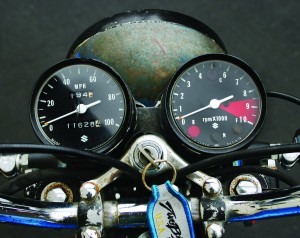
A blossoming of “commuter” bikes was in season, with the Japanese offering an impressive array of sub-200cc machines for under $800. These were cheap to buy, cheap to run, and well suited to the factory worker and the college student. A generation before, Europe had been overrun with efficient little motorcycles, but then the societies became more affluent and could afford small cars; the United States was doing this in reverse, with people forsaking cars to ride motorcycles. Japan had not really arrived at that automobile stage yet, and get-to-work bikes were very popular in that country; the American importers realized there was a market here for such machines.
Suzuki was in its two-stroke stage back then, and had built some exceptional machines in the late 1960s, followed by the excellent triples. One innovation of which the company was most proud was the Ram Air concept, very apparent on this little twin. Take a close look and one sees that this is a vertical twin, parallel cylinders standing upright. The cylinders are perfectly square, 49mm by 49mm, and the air rams are actually built into the cylinder heads. As opposed to being bolted on, as with the 380 and 550 triples.
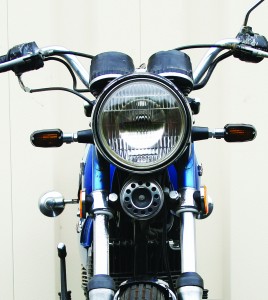
The patented Ram Air design was not of any use around town, but out on the open road it allowed these two-strokes to motor along at close to maximum power with no undue side effects, such as overheating. Focusing the air right over the cylinder heads does wonders in getting rid of the heat. The GT185 ran a healthy 7:1 compression ratio, claiming some 21 horsepower at 7,500 rpm, most of which were galloping along when the speedo needle was at the 75-mph mark.
Two small 20mm Mikuni carbs fed the cylinders, while the Crank Case Injection (CCI) sent oil straight to the main bearings. The gas tank held 2.6 gallons, and the average mileage was a rather low 45 mpg, but two-strokes have never been known for economy. The CCI oil tank held 2.5 pints, and would cover about 500 miles on a pint. Gas and oil were relatively inexpensive back in those days.
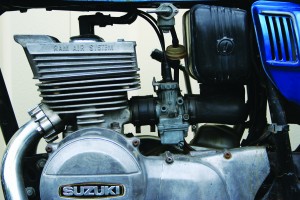
The crankshaft ran on four main bearings, which meant one would have to run the CCI unit dry before any harm would come to the shaft. Small flywheels kept the revs very responsive. At the left end of the crank a sizable armature helped keep the battery charged and electric starter operational…as if one needed an electric starter on this little gem. A kickstarter was also provided, just in case. Or for the nostalgists who did not trust all this new-fangled stuff.
Primary drive was by helical gears, running through an 11-plate wet clutch, five-speed gearbox, and 520-chain final drive. All very normal. Curb weight was just 290 pounds.
The chassis was really the weak point, as Suzuki tried to save money by using the same basic structure for two models, but what was adequate for the GT125 was quite inadequate on the GT185. The frame was a standard cradle made of tubular steel with a single front downtube, and had a rather skinny front fork and preload-adjustable shocks at the back, but this was not really intended for high-speed work. The shocks had chromed exposed springs for the racy look, with short chrome covers at the top for the first three years, which were deleted the last two—to enhance the sporty position. The suspension was weak at both ends, and when pushed into a corner would create a most unnerving wobble. Added to this was a rather steep 27 degrees of rake on the front end, which made handling a bit twitchy on the 52-inch wheelbase. This was all a matter of the manufacturer saving money in order to have a low price, quite understandable. If the rider was just doing normal commuter-type riding on the GT185, all was well and good, but if he was chasing a Yamaha RD200 into a corner, the devil take the hindmost—which would be the Suzuki.
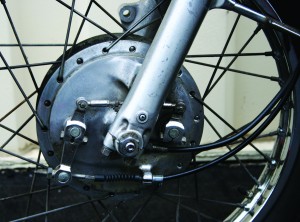
Another flaw was in the braking. On the original ’73 model Suzuki used a double-leading-shoe drum brake, but complaints soon changed that, with a disc being fitted the next year. A skinny 2.75 x 18-inch tire was on the front wheel, a 3.00 x 18 on the back, as was standard for the day.
A 12-month warranty covered 12,000 miles, though few Adventurers ever got ridden to that extent. Speaking of that Adventurer name, the only people who used it were the advertising fellows; it appeared nowhere on the GT185. Around town was the norm for this Grand Touring model, but if the bike did need a new rear tire, it only cost $30.
Even at the end in 1977, the price of the GT185 was well under a thousand dollars. Unbeatable value, but the practical two-stroke was on its way out. New, small four-strokes were proliferating, and one could have bought a 1978 Honda CM185 Twinstar economizer—yes, that numerologist guy seemed to have moved over to Honda.
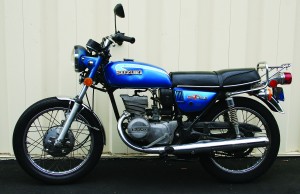
And Suzuki’s other 185s? The TC Ranger was also laid to rest in 1977, while the TS Sierra continued on through 1981.








In 1976 at 16 years of age, I got a new 1976 Suzuki GS185 adventurer. A small starter bike but with 2-stroke, oil injected, twin cylinder gave the little bike lots of get-up-and-go. Unlike a 4-stroke, you would hardly have to touch the electric starter and it would roar to life. I found the engine very smooth and I once blew a 350-4 cylinder Honda away in street race. I knew I couldn’t touch the Honda in top-end but little bike was really quick off the start. I didn’t find out whether the Yamaha 200-twin 2-stroke was quicker or not. I liked the look of the Suzuki better than the Yamaha 200 because the Suzuki had slightly up swept exhaust and a front disc brake instead of a drum. It made the Suzuki safer because of the front disc brake as well.
I owned a GT200 in the UK back in 1984. That little bike was awesome. For it’s size it could really zip along. I was going to college back then and it was a perfect commuter bike but also great for a day trip out to a country pub with the girlfriend. The next level up was the Suzuki X7 250 which was a rocket ship! I had one of those and with bit of tuning & expansion pipes you could keep up with the big boys ( up to 60mph). I did a trip to France on mine but the constant gear changing got you down. That’s when i went to 4 strokes.
I am rebuilding a 1973 Suzuki GT185. Replaced the crank bearings and the electrical harness was toast. I copied the existing harness, and probably also copied the problem, since it now blow a fuse when I toggle the light on button. The lights are on even when in off, and when ”turning them on” it blow the fuse, so at one stage someone did some ”smart” electrical work on the bike that now have me troubled. Will have to check the new built harness against the drawings. Powder coated the frame and re-painted all painted components. Bike was in bad shape, but start to look nice now. Hope to have the electrical wiring issue sorted soon.
I am done now, it is awesome. Rebuilt the entire electrical hardware. Put a few hundred miles on it, but the old piston rings gave in on the left cylinder. Got new pistons and rings. Have honed the cylinders. Need new top end connecting rod bearing, cant fined any. Uhh…
Hey mate I have 2 bikes worth of parts for sale if your keen I’m in Nz 02108425194
Hi do you still have these parts
Enjoyed reading all your comments. I am also restoring a 1973 GT 185. Scored this bike as a basket case for $100. Has 2100 miles and is in awesome condition with all chrome like it left the factory. Had a guy rebuild the Trans. which cost me dearly. Hope it all works out. Would like to talk to any owners to share info. Pls. call Dennis 248-230-0554.